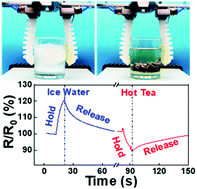Poly(ionic liquid) hydrogel-based anti-freezing ionic skin for a soft robotic gripper†
Abstract
Capable of converting stimuli into electrical signals, hydrogel-based ionic devices are of great significance in soft robots, wearable devices, and artificial sensors. However, profound challenges remain in developing ionic devices that retain their properties in extreme environmental conditions, such as subzero temperatures. Based on a zwitterionic poly(ionic liquid) (PIL), an anti-freezing hydrogel was designed and synthesized for use in a multimodal artificial skin. This zwitterionic PIL hydrogel exhibited super-stretchability (approximately 900%), self-healing ability, and high conductivity (−1.1 S m−1), even at low temperature (−20 °C). Based on this zwitterionic PIL hydrogel, three sensing modes, capacitive, resistive, and triboelectric modes, can be achieved in one device, which is stable under a wide temperature range (−20 °C to 60 °C). Further applications of these multimodal sensors with a soft robotic gripper suggested a new approach for developing sophisticated stimuli-responsive skin with multifunctionality and adaptability to varied environmental conditions.

- This article is part of the themed collections: Materials Horizons 10th anniversary regional spotlight collection: China, Materials Horizons Lunar New Year collection 2021 and 2020 Materials Horizons most popular articles


 Please wait while we load your content...
Please wait while we load your content...